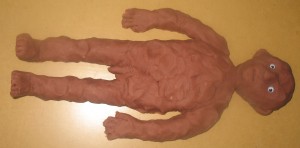Dear 7X,
Ever since you arrived in the school I’ve been convinced that you were bound for greatness. Here is my evidence:
♦You are so ORGANISED. You even use your diaries.
♦You are industrious.
♦You are efficient.
♦You keep me on my toes. When I forget something, you remind me. You’re like walking human diaries. With you, I don’t need a Google calendar or my i-Touch blaring at me to remember something.
Aaaaaah, but despite these sterling qualities, would you be any good at mummifying? Could you deal with a putrefying body at temperatures of more than 40 degrees Celsius, with the relatives checking up on your every move and jackals lurking in the desert? Is this a job that you might undertake only to fail or, worse still, to run from the desert tent before you fainted or vomited?
Even for young people with such promising futures, I feel this kind of role might be seriously traumatic. That’s why we’re going to try it in class, during the last week of term. In the meantime, read up on what you’ll be doing below and, while in the process, you’ll find material for your Emit Repoons assignment.

METHOD AND OTHER GRUESOME DETAILS
The ancient Egyptians had embalming down to a fine art. We know about their methods from both ancient sources (for example, Herodotus, the tourist and historian) and modern analysis. The essential process was to dry the body out by removing as much wet stuff as possible and salting the rest. Sounds simple, doesn’t it? Not really. As you can no doubt imagine, many things can go wrong when you are working with a rotting body in sweltering heat, with jackals roaming around outside and the occasional incompetent embalmer thrown in for good measure.
 My students always seem to be most revolted by the first part of the process. After the body was washed with Nile water, the brain was extracted with an iron hook. This was a tricky task, assisted somewhat by the tendency of the putrefying brain to become quite liquid. The embalmers would break the ethmoid bone and push it up into the cranial cavity, then draw down the brain with the hook. Fragments might also be scooped out with a long-handled spoon. Much of the remainder could be allowed to drip out through the nose. The ancient Egyptians didn’t realise that the brain was an important organ. They thought the seat of reason and emotion was the heart. Therefore they left the heart in and let the brain drain.
My students always seem to be most revolted by the first part of the process. After the body was washed with Nile water, the brain was extracted with an iron hook. This was a tricky task, assisted somewhat by the tendency of the putrefying brain to become quite liquid. The embalmers would break the ethmoid bone and push it up into the cranial cavity, then draw down the brain with the hook. Fragments might also be scooped out with a long-handled spoon. Much of the remainder could be allowed to drip out through the nose. The ancient Egyptians didn’t realise that the brain was an important organ. They thought the seat of reason and emotion was the heart. Therefore they left the heart in and let the brain drain.
Gives a whole new meaning to that phrase, “brain drain”, doesn’t it?
For the high-class corpse the next part of the task was to cut into the flank and remove the stomach, lungs, liver and intestines. Such care was not taken for the cheaper methods of mummification. I’m describing the version used for pharaohs and nobles here. After all, this is a high-class blog.
 A photo of Ramses II’s mummy, provided by Wikimedia Commons and in the public domain
A photo of Ramses II’s mummy, provided by Wikimedia Commons and in the public domain
The cavity would be packed with aromatic substances and linen, and the body would then have natron, a type of salt, packed around it. For forty days the body would be left to dry out, and after this period it looked darker, shrivelled and leathery. To make it appear more life-like, oils might be massaged into the stiff skin; in the later period the emaciated arms and legs were sometimes stuffed with various substances to make them look rounder and more human. The problem was that the fragile skin could easily be torn. This leads me inexorably to the topic of things that could go wrong.

This picture is used courtesy of Wikimedia Commons and is in the public domain. It shows clearly how the skin of a mummy became thin and the limbs emaciated-looking through the process of mummification.
All jobs have their bad points and embalming, perhaps, had more than most. It was easy to make mistakes and difficult to fix them. Embalmers who over-stuffed the limbs of mummies, for instance, could cause havoc. The cheeks of one princess now in the Cairo museum had been padded so much that they burst and had to be restitched. Sometimes bits of bodies were lost, including nipples and penises; they would be replaced with artificial versions, if the embalmer had a conscience. Rats and mice were occasionally caught for ever in the wrappings and mummified along with the person. Some mummies, when unwrapped, have been found to be missing a vital bodily part, such as a foot. All of this serves to show that mummification was a tricky operation.

Anubis performing his role as the protector of the dead; picture provided courtesy of www.freeclipartnow.com (public domain)
 Anyway, after the body was cleaned and repacked with fresh stuffing, it would be bandaged with linen and put into a coffin in the shape of a human being – sometimes several coffins, each nesting in the next like those Russian Matryoshka dolls.
Anyway, after the body was cleaned and repacked with fresh stuffing, it would be bandaged with linen and put into a coffin in the shape of a human being – sometimes several coffins, each nesting in the next like those Russian Matryoshka dolls.
 This image is a drawing of Egyptian coffins, provided by www.karenswhimsy.com
This image is a drawing of Egyptian coffins, provided by www.karenswhimsy.com
No students are ever harmed during our class mummifications. In fact, most students find that the process, while a touch gruesome, is highly entertaining. I knew I had a winning lesson when students started taking pictures of the process with their mobile phones. But the question is, during our class mummification will you be a competent embalmer, or will you be the type about whom an ancient Egyptian might make disparaging remarks?
There’s no way I’m giving my body to that embalmer. She’d be bound to lose a leg or some other part of me that I need for my afterlife.
or…
Why, he can’t even get to class without losing something. And I’m perfectly certain that he can’t sew.
We’ll find out in the last week of term, 7X!
Kind regards from your head embalmer,
Ms Green
Sites that will help you answer the questions in red below:
Ancient Egyptians tormented by their teeth:
Using the ancient Egyptian recipe to mummify a body part:
Try to find answers to the following:
- What problems did the ancient Egyptians have with their teeth?
- What are some diseases that they suffered from?
- Why is it often difficult to tell (a) the cause of death and (b) the likely living weight of the person?
For another source that gives a detailed account of mummification, click HERE.











